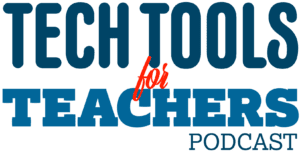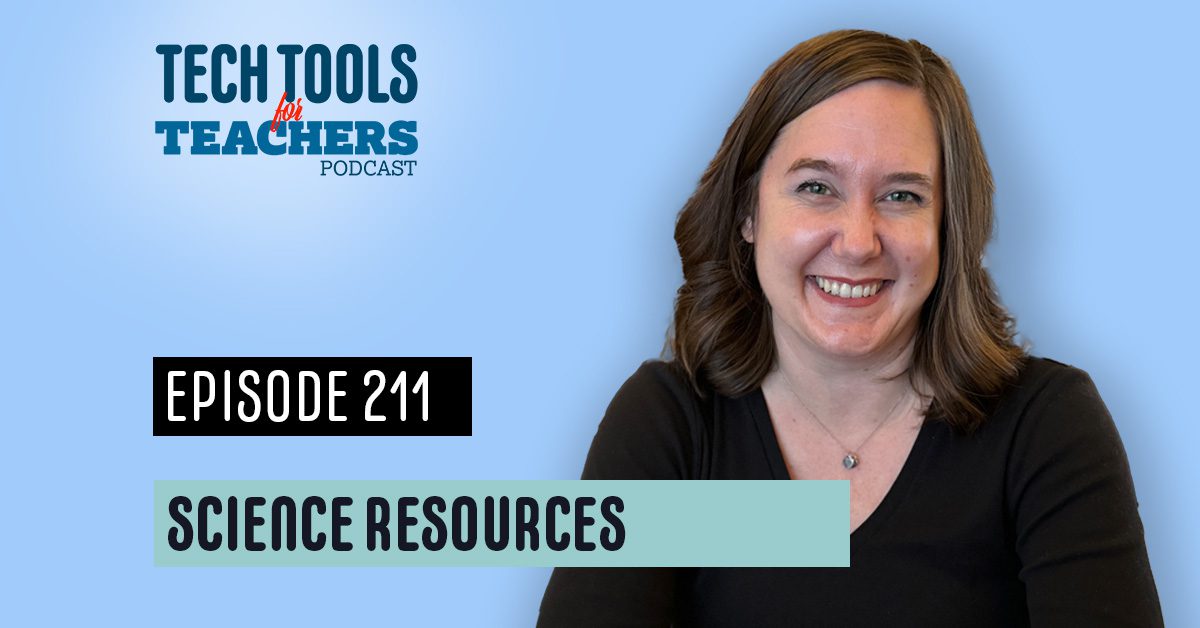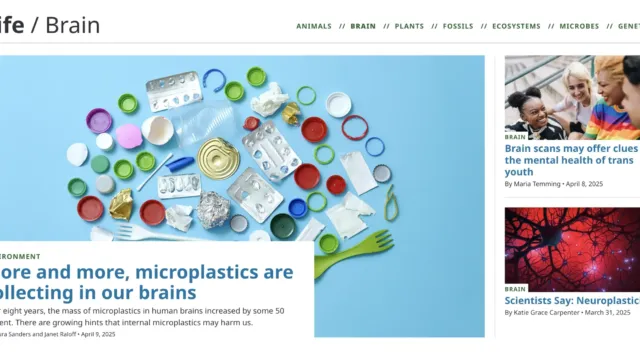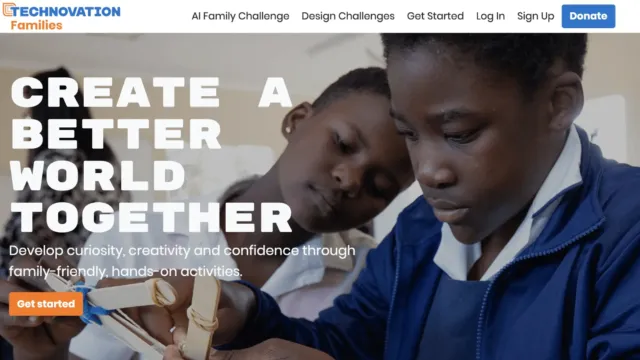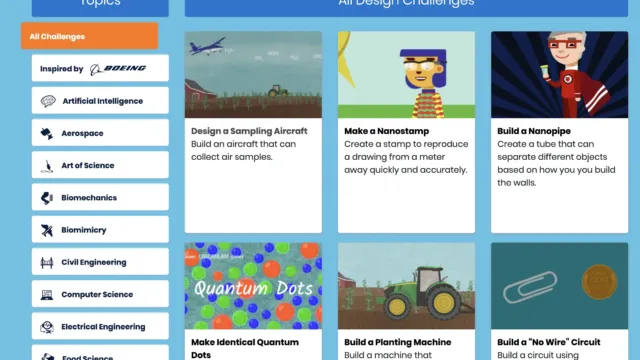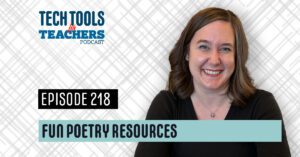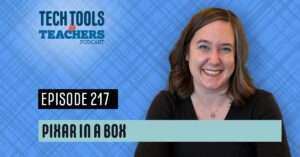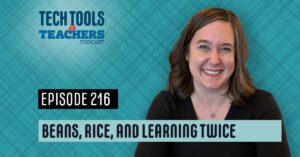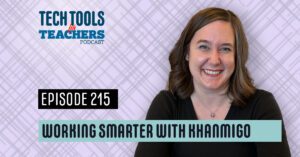[00:00:00] Shanna Martin: Thanks for listening to the Tech Tools for Teachers podcast, where each week we talk about a free piece or two of technology that you can use in your classroom. I’m your host, Shanna Martin. I’m a middle school teacher, technology and instructional coach for my district,
[00:00:31] Fuzz Martin: and I’m a producer and husband.
[00:00:33] Fuzz Martin: The Fuzz Martin Boldly going where no podcast or producer has gone before. Science and space and other things. Uh,
[00:00:44] Shanna Martin: yeah.
[00:00:45] Fuzz Martin: Shanna giggles because I sometimes make faces while she is doing the intro.
[00:00:50] Shanna Martin: This is true.
[00:00:51] Fuzz Martin: I make some like Gen Z faces. Yes. If you’re, if you’ve got Gen Z kids in your classrooms and you all do, uh, you know what it is.
[00:00:59] Fuzz Martin: Yeah. You know what those faces are. There’s a
[00:01:01] Shanna Martin: lot going on. And also it is not pre-recorded. It is at the start of every show. The intro and outro are always
[00:01:09] Fuzz Martin: Oh
[00:01:10] Shanna Martin: yeah. Live,
[00:01:10] Fuzz Martin: always live. And people think that they’re
[00:01:13] Shanna Martin: prerecorded, but
[00:01:13] Fuzz Martin: we’re just so good. And also, we’re on episode, what,
[00:01:17] Shanna Martin: two 11? Two
[00:01:18] Fuzz Martin: 11. So we got.
[00:01:19] Fuzz Martin: We’ve got a little practice.
[00:01:21] Shanna Martin: Yes. Mm-hmm.
[00:01:22] Fuzz Martin: So you wouldn’t know it, by the way, sometimes I deliver this, but Shannon is Uhhuh. Great,
[00:01:30] Shanna Martin: thanks. Uh, yeah, episode two 11. We’re talking about some super cool science things, science
[00:01:36] Fuzz Martin: sciencey things.
[00:01:38] Shanna Martin: And while, yes, I do teach social studies, I do teach technology and I do teach robotics and various other things.
[00:01:43] Shanna Martin: I help lots of teachers in their classrooms and. I always like a good science site that, I mean, it’s meant you can use it in any content area. So,
[00:01:53] Fuzz Martin: okay.
[00:01:53] Shanna Martin: It is a science site, the two sites we’re talking about. So they’re both science related but
[00:01:58] Fuzz Martin: filled with content.
[00:01:58] Shanna Martin: You could definitely include them in a variety of other content areas too.
[00:02:02] Shanna Martin: So it’s not just for science teachers only. So the first site we are gonna talk about is called Science News Explorers. The name of it has changed a little bit over time, but science news. Explorers. It used to be science news for students and various other things. The site itself to get to it is S-N-E-X-P-L-O-R-E s.org,
[00:02:28] Fuzz Martin: SN explorers.org, SN
[00:02:30] Shanna Martin: explorers.org.
[00:02:32] Shanna Martin: And it’s really cool. So my little like top five reasons for liking this site.
[00:02:38] Fuzz Martin: Number one, I’m sorry.
[00:02:41] Shanna Martin: There should be a sound effect there. So, and now I will get one because I said science needs. I don’t know if I sound effects.
[00:02:49] Fuzz Martin: I, I have, I have not. I don’t have a good set of sound effects.
[00:02:53] Shanna Martin: Okay. Well we’ll just make it up in your head.
[00:02:55] Shanna Martin: Choose your number one. Okay. So science articles for all kinds of topics, like it offers all kinds of articles for reading and learning and investigating different types of science. It has collections of resources. So if you’re looking for, um, a specific section, so like in their menu, they have a collection, and then it’ll say like, things about action for the earth or ai, or, um, let’s learn about cer certain topic or jobs and things like that.
[00:03:26] Shanna Martin: We’ll talk about. So there’s like collections of things. So you can set your students on a specific area and then they could just. Research like within these, within this collection. Go ahead and like choose your article. You wanna read, there’s cool experiments that you can do with your students or with families or with children that you are in charge of.
[00:03:48] Shanna Martin: There is job connections, which I think is always important when like kids are learning about a topic, like these are jobs too. Like in your future, if this is interesting to you, you could get paid too. Do this topic. Yeah. And I think talking about that with kids throughout and not like pushing like, oh, you have to pick a job at the age of 10, but just these are jobs that people get paid for.
[00:04:11] Shanna Martin: Like you could do some really cool things out there and make money for it. Um, and then the whole site encourages questions and curiosity, which I think is really important. Always building into your classroom. So there’s just a lot of cool things that I like about this site. So science news explorers, I will say they highlight like their purpose is like ages nine and up is like their focus, when it comes to the information that they have.
[00:04:35] Shanna Martin: So just keep that in mind. And if you’re at the homepage, uh, today’s highlighted article is on Agriculture, A Secret Climate Superhero Lies Beneath Our Farms.
[00:04:47] Fuzz Martin: I’ve been reading the one on the top right.
[00:04:50] Shanna Martin: Physics finally explains the sound of clapping.
[00:04:53] Fuzz Martin: Oh, no. Oh. Uh, let’s see. Uh, lots
[00:04:55] Shanna Martin: of these fly larva mimic a termite’s face.
[00:04:58] Fuzz Martin: That’s the one, uh, with the beginning. But what have you
[00:05:02] Shanna Martin: learned? Uh,
[00:05:03] Fuzz Martin: well, uh, this termite mimics, uh, its, but mimics a, this bowly larvae it’s butt closely resembles that of termite eyes. Mm-hmm. So when the larvae is living in a termite’s nest. That the termites leave it alone. ’cause I think it’s one of them, one of us.
[00:05:22] Fuzz Martin: But it’s really just, its butt interesting. And it also breeds through interest, uh, nostrils in its butt. So there you go. There is your wow. Science news explorers.
[00:05:30] Shanna Martin: Thanks for sharing.
[00:05:31] Fuzz Martin: Yeah.
[00:05:32] Shanna Martin: Um, and all of the articles are super relevant. Like that one was written April 21st. Uh, so they’re up to date with the information that they are sharing.
[00:05:42] Shanna Martin: There’s also obviously engaging stories and they’re not super long. Mm-hmm. So you can easily. Read an article in class, analyze it, share the information online. They also have, with each article, they have a section called like Power words. Yeah. So the words that are bold or focused on, then they have the definitions that go with them.
[00:06:02] Shanna Martin: And it’s cool ’cause it makes it printable. So that way you have like, if you want the students to do some analysis of that vocabulary, you can, like, they make a little printable list for the vocabulary that they share. And they also have the citations at the bottom, which is always important ’cause I’m.
[00:06:16] Shanna Martin: Trying to teach my kids, like information comes from other places and you can’t just like say it’s yours. Sure. Um, which is a constant in middle school. So like, that’s like, it’s pulled up the physics. What’s cool is, okay, so when you’re on the site, a couple of things you can go on all topics.
[00:06:30] Shanna Martin: If you click on that, it will give you like earth, humans, life, physics, space technology, chemistry, math, science and society. So they have different topics. If you want things specific to life, then. Under life category, we’ll give you animals, the brain plants, fossils, ecosystems, microbes and genetics. Under humans, there’s human health and medicine.
[00:06:54] Shanna Martin: Archeology,
[00:06:55] Fuzz Martin: psychology,
[00:06:55] Shanna Martin: psychology. I started like reading of the art ’cause the article, like the titles are really interesting. Earth, you got environment, climate, oceans, agriculture space, planets and the Universe, technology Computing and ai. So those are like your overall topics that you can choose from to again, find information and read these articles, which are very, they’re just very engaging.
[00:07:17] Shanna Martin: And then also in your little search bar across tap in the menu, there are like. Other resources that as a teacher are fabulous. So they have like the word of the week and then it will give you like specific article that goes like the word of the week and it will give you more information. You can go under that.
[00:07:37] Shanna Martin: I talked about like when it’s highlighting things, it’s called the Cool Jobs Collection and it’s a series explorers career in STEM jobs and from like math to fossils to computing. It just highlights different jobs. They have inventions and innovations and they have a whole section that you can pull up that, especially if you’re doing some sort of invention.
[00:07:58] Shanna Martin: Actually, our daughter who’s in fourth grade just finished, like an inventions unit in reading class, and then they built their own inventions. Like this would be a great resource for those kids to be able to pull up. Additional information about other inventions that exist. And then they also have classroom questions where they have like questions that you can pose as a class and then you can do an investigation on that.
[00:08:19] Shanna Martin: So it encourages, questioning and exploring things. Mm-hmm. Which is very cool. There’s just so many different resources they have explainers, like what is a dinosaur and what is asthma and how is it treated? And, purple only exists in our brains.
[00:08:34] Fuzz Martin: Yeah. For some of you. Did you know that? I did not know that.
[00:08:37] Fuzz Martin: Also, uh,
[00:08:39] Shanna Martin: we call Purple under
[00:08:39] Fuzz Martin: Cool Jobs. I’m sad to report podcast producer is not listed.
[00:08:46] Shanna Martin: Um, well see who needs buttons for sound effects. That’s right. So anyway, science News Explorers just has all kinds of very cool resources. They also have a section on educational resources that would be helpful for teachers.
[00:09:00] Shanna Martin: It goes along with news stories, versus explainers versus experiments. Kind of walks you through like what you could use in your classroom. So just lots of cool things. Doesn’t matter what content you teach, you could find some very cool resources and articles for your students. I like to. Sometimes share articles like, Hey, within these three, like you can choose research it and then share information within your group or within the class, so that way they kinda get some choice in what they’re doing.
[00:09:25] Shanna Martin: Mm-hmm. And you can also share them pretty easily. You can just take the links and you can drop them, in various places. And the articles also, at the bottom of each article has. Where you can post it. Mm-hmm. Like to social media and stuff too, if you wanted to. So. Sure. It also
[00:09:39] Fuzz Martin: has a, uh, readability score on each article as well, so yeah, it gives you the flesh Kincaid grade level score,
[00:09:45] Shanna Martin: which is super helpful.
[00:09:46] Shanna Martin: Yeah. So a lot of cool things, a lot of great resources for teachers and of course all free, which we love about. Use tools.
[00:09:54] Fuzz Martin: That’s, that’s why we do this. It is, that’s why we don’t have any sponsors on the show. Also. Ah, Hey, is gonna advertise on, uh,
[00:10:04] Shanna Martin: on this free,
[00:10:05] Fuzz Martin: on this podcast about free tools and we tell you how to get around paying for tools you want, you wanna do that, you wanna give us some money for that?
[00:10:13] Shanna Martin: Nice. Uh, so Science news explorers, check it out.
[00:10:16] Fuzz Martin: Yep.
[00:10:17] Shanna Martin: It’s a very cool tool. Okay. Our second tool
[00:10:19] Fuzz Martin: next.
[00:10:21] Shanna Martin: Is also science related. And this one is called Tech Novation. It’s a, for families, it’s a way for families to get involved with some research, or with uh, like kinda design challenges and things like that.
[00:10:33] Shanna Martin: But you could totally pose these to your students in your classroom or just share them out as extra things for kids to do. I think of like summertime and use some challenges for kids. Like, Hey, test this out. You’ll find it though. So it’s tech novation families, but. The actual website itself is curiosity machine.org, so C-U-R-I-O-S-I-T-Y-M-A-C-H-I-N e.org.
[00:10:56] Shanna Martin: So curiosity machine.org, and it is just a super cool, you sign up, you get started for free. Go ahead and log in. If you wanna check it out before you log in though, you can just go and you can explore this site. It actually offers quite a bit to you without having to sign up for anything. And, they will share like their whole community of learners.
[00:11:17] Shanna Martin: What’s cool across the top is if you click on design challenges, and this is I think probably the highlight for me. As if you go under design challenges, they have STEM activities under like a variety of topics. So you can do stem, like these design challenges under like ai, aerospace, art of science, biomechanics, um, biomimicry, civil engineering, computer science, electrical engineering, food science, material science, mechanical engineering, ocean engineering, robotics and satellite systems.
[00:11:47] Shanna Martin: Okay, I’m gonna click on civil engineering. So you pick your topic and then it gives you civil engineering design challenges. Okay? Again, you can sign up and have access to this, but you could also access this without signing up. And if you go under civil engineering, I pick the first one. It’s build a planting machine.
[00:12:13] Shanna Martin: So build a planting machine that distributes seeds precisely. Okay. You can part, when you’re a part of the community, you have more access, but if you’re just on the site, they have a little inspiration video so you can like get a little background, like, why are we doing this? Where’s it coming from? It’s a little over three minutes, close to four.
[00:12:33] Shanna Martin: Then they have suggested materials, so like toilet paper tubes, cardboard things, straws, masking tape. Tissue boxes, marbles, D cups be its marble, you know? Okay. They have difficulty level rating, so it’ll tell you like where you’re at, kinda with design challenge, and then you can go from there. Like you can just set up your kids with that if you choose to.
[00:12:55] Shanna Martin: Mm-hmm. When you log in, it will give you more details to the challenge and all of the pieces that go to it, but honestly, as a teacher you’d be like, this is our design challenge. You throw the supplies at the kids and then see what they come up with.
[00:13:05] Fuzz Martin: Sure.
[00:13:06] Shanna Martin: Which is. Like, one of my favorite things to do is to be like, here, make something outta this stuff.
[00:13:12] Shanna Martin: Now. Explain why it did or didn’t work. Mm-hmm. And then tell me what you could have changed for next time. They have like just all kinds of cool ideas. Build a no wire circuit. You can engineers a safe stopping robot and material science you can focus on. Making build DNA origami inspired structure.
[00:13:36] Fuzz Martin: You can build a self-propelling boat,
[00:13:38] Shanna Martin: you can build a water filter, and again, there’s a little inspiration video, so just materials, difficulty level that part’s laid out for you. And then you can design, you can design, like join the design challenges and then be a part of it as well in their community.
[00:13:53] Shanna Martin: So there’s just a lot of cool things, resources. Sign yourself up again. You’re able to participate. Anyone can sign up. There’s no cost to it. It’s just a way of like putting these concepts together. And then also connecting it with AI and things like that within the community. So there’s an AI family challenge that goes with it too.
[00:14:12] Shanna Martin: So there’s family challenges, classroom challenges, and you can map it all. And there’s lessons that go with it. So tech innovation, families, lot of cool resources. Building some curiosity with your students. It’s just a cool resource. So I suggest you check that one out as well. Yes, because there’s cool things.
[00:14:32] Shanna Martin: There’s just a lot of cool things to investigate.
[00:14:34] Fuzz Martin: So yes, tech Innovation Families was formerly Curiosity Machine.
[00:14:38] Shanna Martin: Yep. But that’s still the website
[00:14:39] Fuzz Martin: to go to. Yeah. Yes. So
[00:14:41] Shanna Martin: there you go. Fun, sciencey things. Explore them, try them out. You don’t have to be a science teacher to check these out. Yeah. They just kind of like cool things.
[00:14:51] Shanna Martin: Integrate in your classroom.
[00:14:52] Fuzz Martin: Mm-hmm.
[00:14:53] Shanna Martin: For Engage your students.
[00:14:54] Fuzz Martin: Very good
[00:14:55] Shanna Martin: today,
[00:14:55] Fuzz Martin: td.
[00:14:56] Shanna Martin: Thanks for tuning in. This has been The Tech Tools for Teachers Podcast recorded. If you ever have any questions, you can find me on Blue Sky Threads, Facebook, Instagram, smart in wi. And if you wanna get more information on the links to the technology discuss in this episode, you can visit smartinwi.com.
[00:15:13] Shanna Martin: If you’d like to support the show, please consider buying me a coffee or two. Visit. buymeacoffe.com/smartinwi or visit smartinwi.com and click on that cute little purple coffee cup. Your donations help keep the show going. New episodes each week. Thanks for listening. Go educate and innovate.
[00:15:28] Fuzz Martin: I’ve been reading this disclaimer since January 6th, 2019.
[00:15:31] Fuzz Martin: The ideas and opinions expressed on this podcast and the smartinwi.com website. Are those of the authors, Shanna Martin, and not of her employer? Prior to using any of the technologies discussed on this podcast, please consult with your employer regulations. This podcast offers no guarantee that these tools will work for you as described, but we sure hope they do, and we’ll talk to you next time here on The Tech Tools for Teachers Podcast.
[00:16:01] Fuzz Martin: Sh.
